Download CBSE Class 11 Computer Science List in Python Notes in PDF format. All Revision notes for Class 11 Computer Science have been designed as per the latest syllabus and updated chapters given in your textbook for Computer Science in Class 11. Our teachers have designed these concept notes for the benefit of Class 11 students. You should use these chapter wise notes for revision on daily basis. These study notes can also be used for learning each chapter and its important and difficult topics or revision just before your exams to help you get better scores in upcoming examinations, You can also use Printable notes for Class 11 Computer Science for faster revision of difficult topics and get higher rank. After reading these notes also refer to MCQ questions for Class 11 Computer Science given on studiestoday
Revision Notes for Class 11 Computer Science List in Python
Class 11 Computer Science students should refer to the following concepts and notes for List in Python in Class 11. These exam notes for Class 11 Computer Science will be very useful for upcoming class tests and examinations and help you to score good marks
List in Python Notes Class 11 Computer Science
7.1 Introduction:
- List is a collection of elements which is ordered and changeable (mutable).
- Allows duplicate values.
- A list contains items separated by commas and enclosed within square brackets ([ ]).
- All items belonging to a list can be of different data type.
- The values stored in a list can be accessed using the slice operator ([ ] and [:]) with indexes starting at 0 in the beginning of the list.
Difference between list and string:

7.2 Creating a list:
To create a list enclose the elements of the list within square brackets and separate the elements by commas.
Syntax: list-name= [item-1, item-2, …….., item-n]
Example:
mylist = [“apple”, “banana”, “cherry”] # a list with three items
L = [ ] # an empty list
7.2.1 Creating a list using list( ) Constructor:
o It is also possible to use the list( ) constructor to make a list.
mylist = list((“apple”, “banana”, “cherry”)) #note the double round-brackets print(mylist)
L=list( ) # creating empty list
7.2.2 Nested Lists:
>>> L=[23,’w’,78.2, [2,4,7],[8,16]]
>>> L
[23, ‘w’, 78.2, [2, 4, 7], [8, 16]]
7.2.3 Creating a list by taking input from the user:
>>> List=list(input(“enter the elements: “))
enter the elements: hello python
>>> List
[‘h’, ‘e’, ‘l’, ‘l’, ‘o’, ‘ ‘, ‘p’, ‘y’, ‘t’, ‘h’, ‘o’, ‘n’]
>>> L1=list(input(“enter the elements: “))
enter the elements: 678546
>>> L1 [‘6’, ‘7’, ‘8’, ‘5’, ‘4’, ‘6’]
# it treats elements as the characters though we entered digits
To overcome the above problem, we can use eval( ) method, which identifies the data type and evaluate them automatically.
>>> L1=eval(input(“enter the elements: “))
enter the elements: 654786
>>> L1
654786 # it is an integer, not a list
>>> L2=eval(input(“enter the elements: “))
enter the elements: [6,7,8,5,4,3] # for list, you must enter the [ ] bracket
>>> L2
[6, 7, 8, 5, 4, 3]
Note: With eval( ) method, If you enter elements without square bracket[ ], it will be considered as a tuple.
>>> L1=eval(input(“enter the elements: “))
enter the elements: 7,65,89,6,3,4 >>> L1
(7, 65, 89, 6, 3, 4) #tuple
7.3 Accessing lists:
- The values stored in a list can be accessed using the slice operator ([ ] and [:]) with indexes.
- List-name[start:end] will give you elements between indices start to end-1.
- The first item in the list has the index zero (0).
Example: >>> number=[12,56,87,45,23,97,56,27]

number[2]
87 >>>
number[-1]
27
>>> number[-8]
12 >>> number[8]
IndexError: list index out of range
>>> number[5]=55 #Assigning a value at the specified index
number [12, 56, 87, 45, 23, 55, 56, 27]
7.4 Traversing a LIST:
Traversing means accessing and processing each element.
Method-1:
>>> day=list(input(“Enter elements :”))
Enter elements : sunday
>>> for d in day:
print(d)
Output:
s
u
n
d
a
y
Method-2
>>> day=list(input(“Enter elements :”))
Enter elements : wednesday
>>> for i in range(len(day)): print(day[i])
Output:
w
e
d
n
e
s
d
a
y
7.5 List Operators:
- Joining operator +
- Repetition operator *
Slice operator [ : ]
Comparison Operator <, <=, >, >=, ==, !=
Joining Operator: It joins two or more lists.
Example: >>> L1=[‘a’,56,7.8] >>> L2=[‘b’,’&’,6] >>> L3=[67,’f’,’p’] >>> L1+L2+L3 [‘a’, 56, 7.8, ‘b’, ‘&’, 6, 67, ‘f’, ‘p’]
Repetition Operator: It replicates a list specified number of times.
Example: >>> L13 [‘a’, 56, 7.8, ‘a’, 56, 7.8, ‘a’, 56, 7.8] >>> 3L1 [‘a’, 56, 7.8, ‘a’, 56, 7.8, ‘a’, 56, 7.8]
Slice Operator:
List-name[start:end] will give you elements between indices start to end-1.
>>> number=[12,56,87,45,23,97,56,27]
>>> number[2:-2]
[87, 45, 23, 97]
>>> number[4:20]
[23, 97, 56, 27]
>>> number[-1:-6]
[ ]
>>> number[-6:-1]
[87, 45, 23, 97, 56]
number[0:len(number)]
[12, 56, 87, 45, 23, 97, 56, 27]
List-name[start:end:step] will give you elements between indices start to end-1 with skipping elements as per the value of step.
>>> number[1:6:2]
[56, 45, 97]
>>> number[: : -1]
[27, 56, 97, 23, 45, 87, 56, 12]
#reverses the list
List modification using slice operator:
>>> number=[12,56,87,45,23,97,56,27]
>>> number[2:4]=[“hello”,”python”]
>>> number
[12, 56, ‘hello’, ‘python’, 23, 97, 56, 27]
>>> number[2:4]=[“computer”] >>> number [12, 56, ‘computer’, 23, 97, 56, 27]
Note: The values being assigned must be a sequence (list, tuple or string)
Example: >>> number=[12,56,87,45,23,97,56,27]
>>> number=[12,56,87,45,23,97,56,27]
>>> number[2:3]=78 # 78 is a number, not a sequence
TypeError: can only assign an iterable
Comparison Operators:
o Compares two lists
o Python internally compares individual elements of lists in lexicographical order.
o It compares the each corresponding element must compare equal and two sequences must be of the same type.
o For non-equal comparison as soon as it gets a result in terms of True/False, from corresponding elements’ comparison. If Corresponding elements are equal, it goes to the next element and so on, until it finds elements that differ.
Example:
L1, L2 = [7, 6, 9], [7, 6, 9]
L3 = [7, [6, 9] ]
For Equal Comparison:
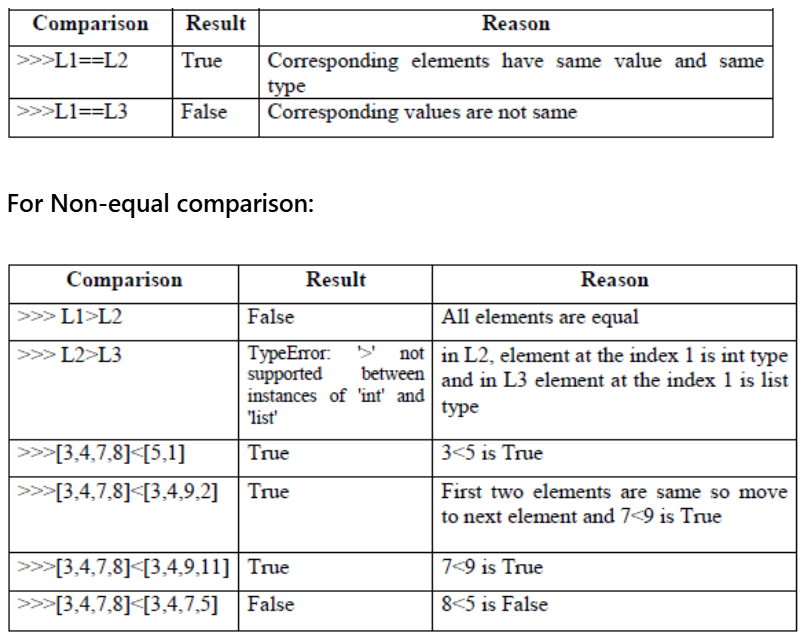
List Methods:
Consider a list:
company=[“IBM”,”HCL”,”Wipro”]
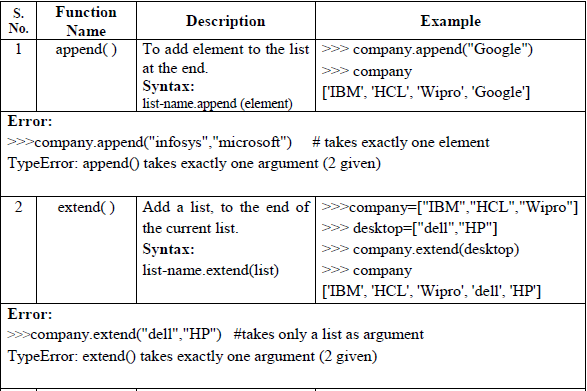
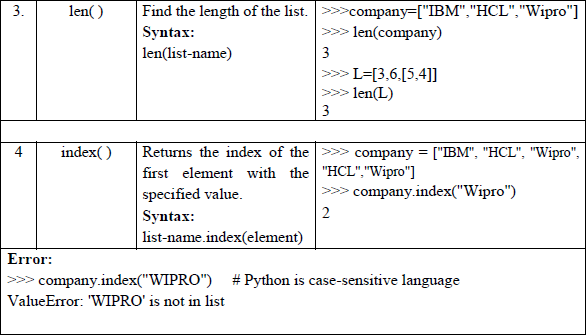
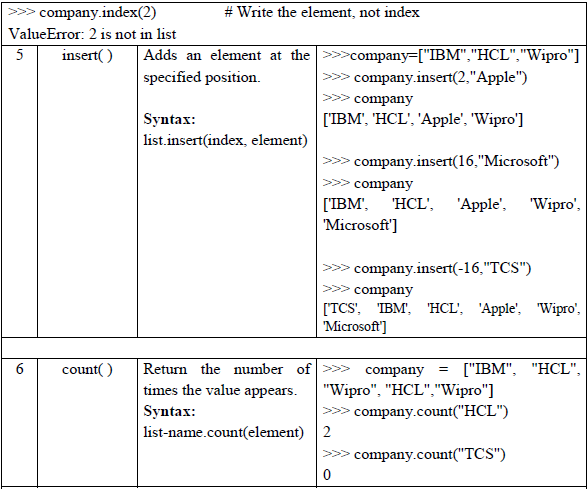
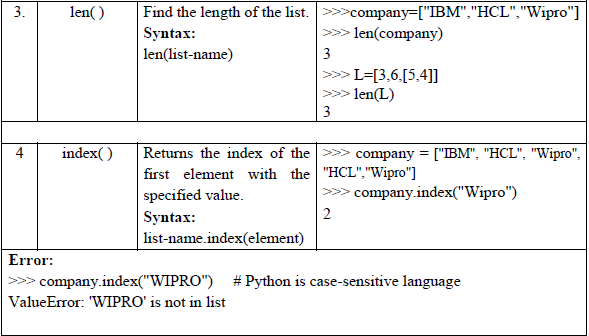
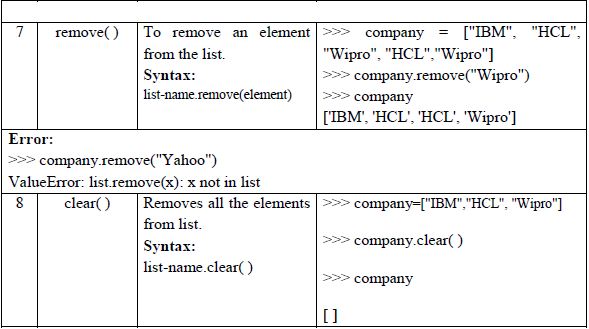
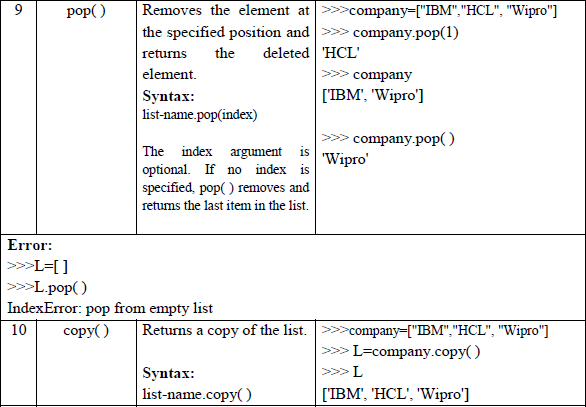
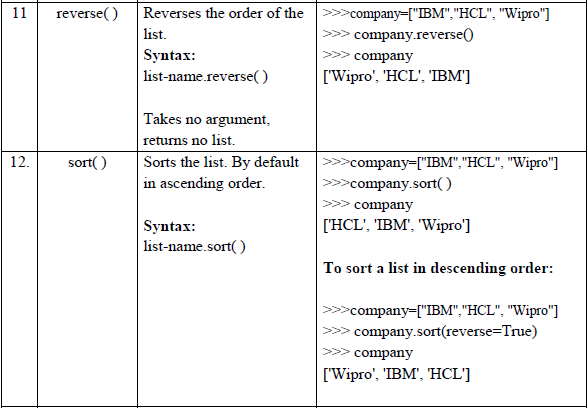
Deleting the elements from the list using del statement:
Syntax:
del list-name[index] # to remove element at specified index del list-name[start:end] # to remove elements in list slice
Example:
>>> L=[10,20,30,40,50]
>>> del L[2] # delete the element at the index 2
>>> L
[10, 20, 40, 50]
>>> L= [10,20,30,40,50]
>>> del L[1:3]
# deletes elements of list from index 1 to 2.
>>> L
[10, 40, 50]
>>> del L # deletes all elements and the list object too.
>>> L
NameError: name ‘L’ is not defined
Difference between del, remove( ), pop( ), clear( ):
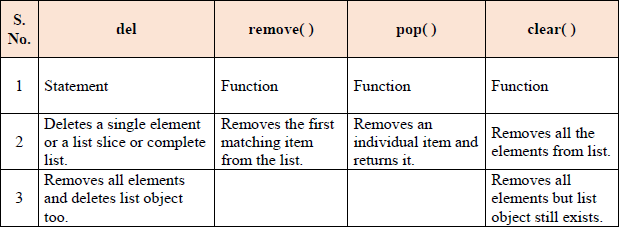
Difference between append( ), extend( ) and insert( ) :
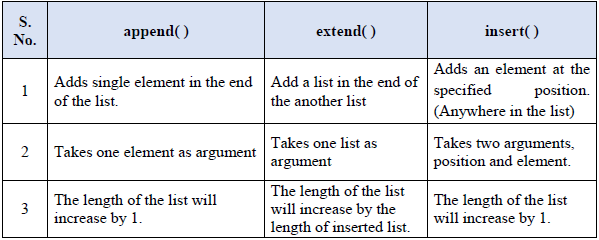
ACCESSING ELEMENTS OF NESTED LISTS:
Example:
L=[“Python”, “is”, “a”, [“modern”, “programming”], “language”, “that”, “we”, “use”]
L[0][0]
‘P’
L[3][0][2]
‘d’
https://pythonschoolkvs.wordpress.com/ Page 73
L[3:4][0]
[‘modern’, ‘programming’]
L[3:4][0][1]
‘programming’
L[3:4][0][1][3]
‘g’
L[0:9][0]
‘Python’
L[0:9][0][3]
‘h’
L[3:4][1]
IndexError: list index out of range
Programs related to lists in python:
Program-1 Write a program to find the minimum and maximum number in a list.
L=eval(input(“Enter the elements: “))
n=len(L)
min=L[0]
max=L[0]
for i in range(n):
if min>L[i]:
min=L[i]
if max<L[i]:
max=L[i]
print(“The minimum number in the list is : “, min)
print(“The maximum number in the list is : “, max)
Program-2 Find the second largest number in a list.
L=eval(input(“Enter the elements: “))
n=len(L)
max=second=L[0]
for i in range(n):
if maxsecond:
max=L[i]
seond=max
print(“The second largest number in the list is : “, second)
Program-3: Program to search an element in a list. (Linear Search).
L=eval(input(“Enter the elements: “))
n=len(L)
item=eval(input(“Enter the element that you want to search : “))
for i in range(n):
if L[i]==item:
print(“Element found at the position :”, i+1)
break
else:
print(“Element not Found”)
Output:
Enter the elements: 56,78,98,23,11,77,44,23,65
Enter the element that you want to search : 23
Element found at the position : 4
| CBSE Class 11 Computer Science Flow of Control Notes |
| CBSE Class 11 Computer Science Functions Notes Set A |
| CBSE Class 11 Computer Science Functions Notes Set B |
CBSE Class 11 Computer Science List in Python Notes
We hope you liked the above notes for topic List in Python which has been designed as per the latest syllabus for Class 11 Computer Science released by CBSE. Students of Class 11 should download and practice the above notes for Class 11 Computer Science regularly. All revision notes have been designed for Computer Science by referring to the most important topics which the students should learn to get better marks in examinations. Our team of expert teachers have referred to the NCERT book for Class 11 Computer Science to design the Computer Science Class 11 notes. After reading the notes which have been developed as per the latest books also refer to the NCERT solutions for Class 11 Computer Science provided by our teachers. We have also provided a lot of MCQ questions for Class 11 Computer Science in the notes so that you can learn the concepts and also solve questions relating to the topics. We have also provided a lot of Worksheets for Class 11 Computer Science which you can use to further make yourself stronger in Computer Science.
You can download notes for Class 11 Computer Science List in Python for latest academic session from StudiesToday.com
Yes, the notes issued for Class 11 Computer Science List in Python have been made available here for latest CBSE session
There is no charge for the notes for CBSE Class 11 Computer Science List in Python, you can download everything free of charge
www.studiestoday.com is the best website from which you can download latest notes for List in Python Computer Science Class 11
Come to StudiesToday.com to get best quality topic wise notes for Class 11 Computer Science List in Python

